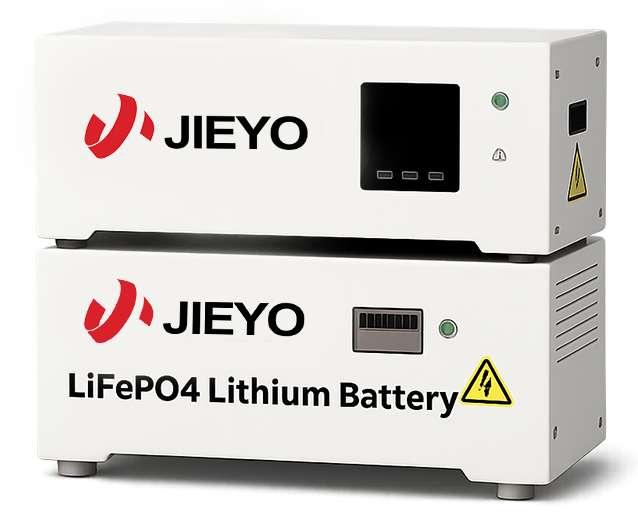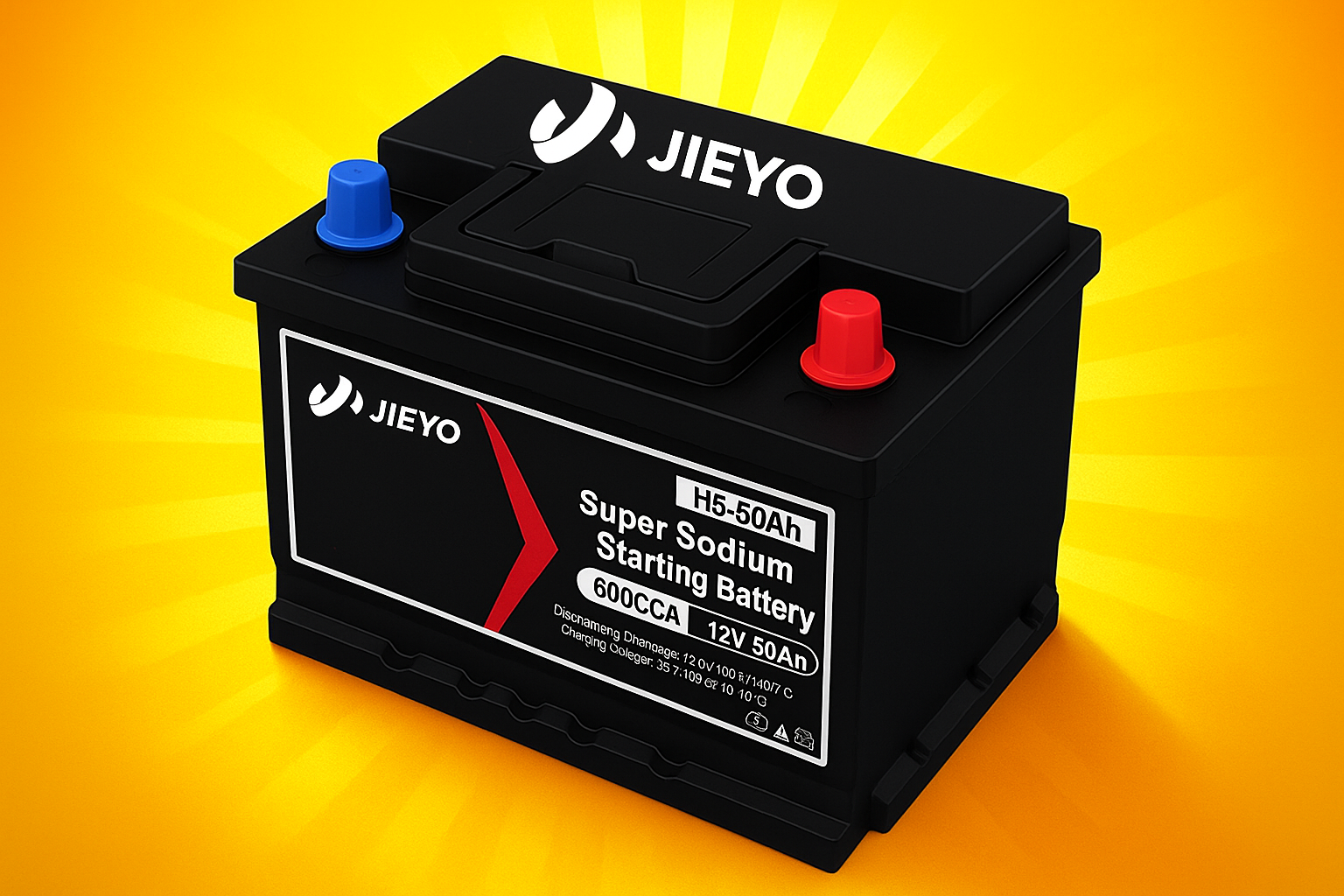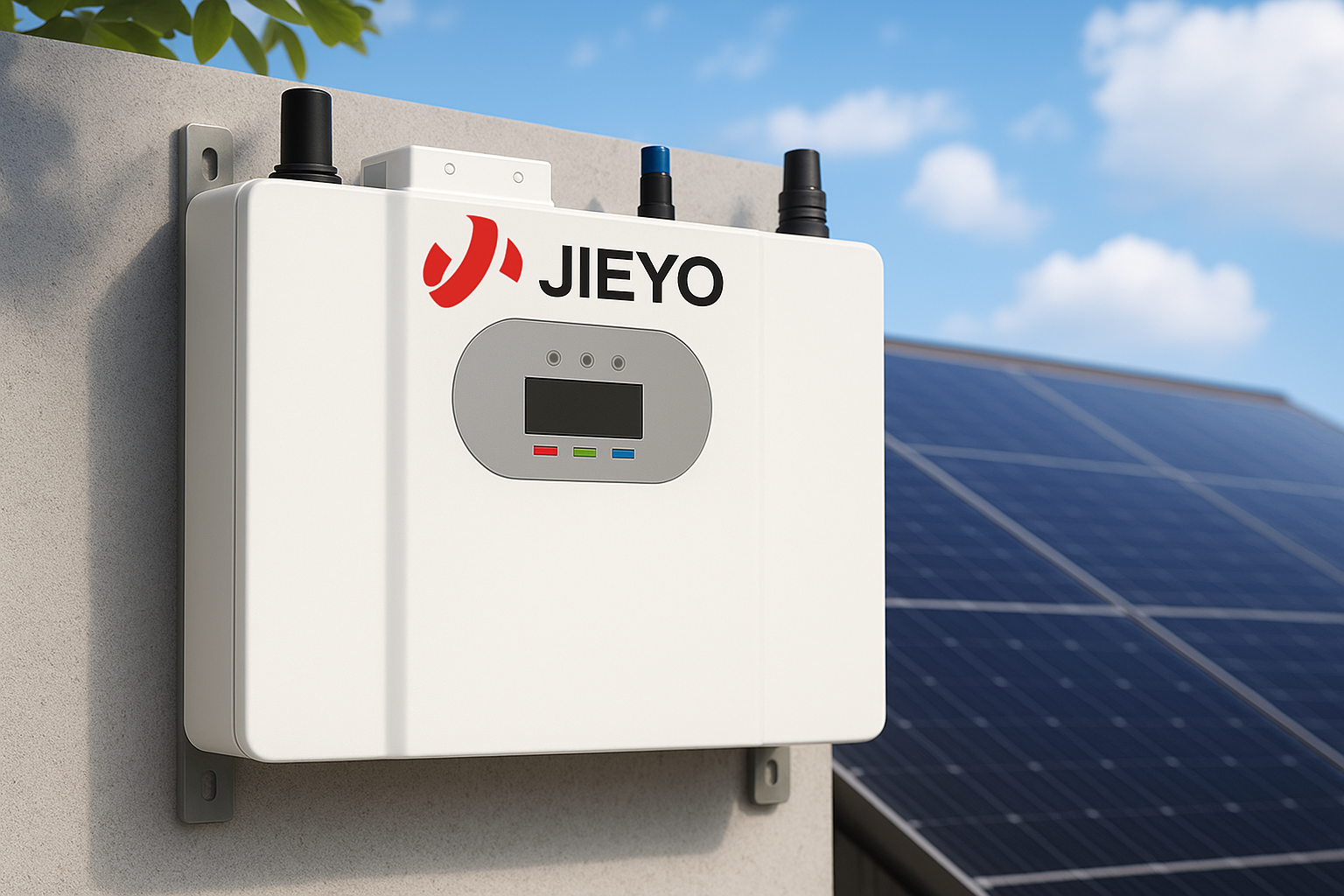描述
JIEYO Stackable Energy Storage Battery — 48 V / 51.2 V LiFePO₄, 5 kWh–25 kWh, CAN/RS485, 6000+ Cycles
的 捷陽堆疊式儲能電池 is a modular, high-safety LiFePO₄ storage system engineered for residential and light-commercial solar applications. Each 51.2 V module provides approximately 5.12 kWh of usable energy, and modules stack vertically to scale from 5 kWh up to 25 kWh (and beyond in multi-stack arrays). With LFP chemistry, 6000+ cycle life以及 CAN/RS485/RS232 communications to mainstream hybrid inverters, it is the practical core of an off-grid, hybrid, or on-grid backup system.
High-Performance LFP Platform (48 V / 51.2 V)
-
化學: 磷酸鋰鐵(LiFePO₄ / LFP)具有固有的穩定熱行為和長使用壽命。
-
Nominal module voltage: 51.2 V (16S LFP)。
-
Energy per module: ≈ 5.12 kWh; stack 1–5 modules for ≈ 5–25 kWh.
-
循環壽命: 6000+ 循環 (typical residential depth-of-discharge), supporting 10+ years of daily use.
-
往返效率: high (> 95% typical), reducing system losses and improving PV self-consumption.
-
低自放電: holds charge well during seasonal or emergency standby.
為何選擇 LFP 作為家用儲存設備? 與 NMC 和鉛酸蓄電池相比,LFP 具有以下優點 超長週期壽命, 更好的熱穩定性以及 flatter voltage curves, which translate into predictable performance and lower lifetime cost per kWh.
True Stackable, Tool-Lite Installation
-
Vertical stack design: modules align and lock mechanically; an upper control/BMS pack manages the whole stack.
-
Floor-standing or cabinet/rack options: fits utility rooms, garages, equipment closets, or inverter walls.
-
Quick electrical interconnects: short, labeled DC busbars/cables minimize wiring time and error.
-
Expandable later: start at 5 kWh and expand to 10/15/20/25 kWh as loads grow—no redesign required.
-
Clean footprint: narrow depth for tight spaces; front service access simplifies maintenance.
智慧型 BMS 與系統通訊
-
包裝監控: real-time voltage, current, temperature, and state-of-charge with cell balancing.
-
保護: over/under-voltage, over-current, short-circuit, over/under-temperature, and charge/discharge cutoff.
-
介面: CAN / RS485 / RS232 for closed-loop communication to hybrid inverters and energy gateways.
-
Event logging: aids diagnostics and after-sales service; supports firmware updates (where applicable).
-
Compatibility: suitable for off-grid, hybrid-grid, and on-grid topologies; inverter brand maps available on request.
並網模式
-
離網: pair with a compatible hybrid/off-grid inverter for autonomous power where no utility is present.
-
混合電網: self-consumption, peak-shaving, and time-of-use arbitrage; charge from PV by day, discharge at peak.
-
並網備份: maintain essential circuits during outages using an ATS/backup output from the inverter (per local code).
機械與環境工程
-
保護等級: options up to IP54–IP65 (model-dependent), resisting dust and incidental moisture.
-
Cooling: 風冷式 thermal path designed for quiet operation and long life.
-
Enclosure: steel or alloy shell with powder-coat finish; corner reinforcement for logistics and on-site handling.
-
可維修性: modular architecture allows replacement at module level to minimize downtime.
安全設計
-
Cell-level LFP safety with ceramic separators and prismatic/EV-grade cells.
-
Pack fusing & contactors with pre-charge circuits to protect busbars and inverter DC link.
-
隔離與絕緣 tested to relevant standards; creep distances respected for high-voltage stacks.
-
Compliance documentation: CE / RoHS / MSDS / UN38.3 可用於物流和市場進入。
典型電氣特性*
(*Values vary by configuration; ask for the exact datasheet for your market.)
-
Nominal voltage: 51.2 V per module; multi-module stacks managed by BMS.
-
Usable energy: ≈ 5.12 kWh per module; 10–25 kWh in 2–5 module stacks.
-
Recommended C-rate: 0.5 C continuous; 1 C peak capability depending on inverter and ambient conditions.
-
DoD window: 90–100% configurable; standard warranty tied to recommended DoD.
-
往返效率: > 95% typical with modern hybrids.
-
Temperature: charge 0–45 °C, discharge −10–55 °C (typ.); store at 15–30 °C for best life.
-
通訊: CAN / RS485 / RS232 with vendor-specific protocols selectable via DIP/firmware.
Use Cases
-
Residential PV self-consumption: store daytime solar to cover evening peaks; raise PV utilization.
-
Backup power: keep routers, lighting, computers, security systems, fridges and circulation pumps running during outages.
-
Peak-shaving & TOU: charge off-peak, discharge on-peak to reduce bills.
-
Small C&I micro-grids: stabilize loads in retail, workshops, telecom shelters, and remote cabins.
-
RV/Marine cabins & lodges: stationary stacks can support longer stays with quiet, fuel-free energy.
系統規格範例 (說明)
-
5 kWh (1× module): small apartments, routers/IT + lighting + intermittent appliance backup.
-
10 kWh (2×): typical 3–5 kW hybrid inverter for evening consumption and brief outages.
-
15 kWh (3×): longer autonomy for fridges, work-from-home setups, and pumps.
-
20–25 kWh (4–5×): extended backup for larger homes; pairs well with 8–12 kW PV arrays and 8–10 kW hybrids.
For runtime planning, a quick estimate is:
Runtime (h) ≈ Capacity (Wh) × DoD × system efficiency / average load (W).
At 25 kWh with 90% DoD and 92% system efficiency, you have ≈ 20.7 kWh usable—enough for ~20 hours at 1 kW average.
安裝與試運轉注意事項
-
Inverter pairing: choose an inverter with a supported CAN/RS485 profile; set battery type to LFP and select the JIEYO (or compatible) profile.
-
DC wiring: observe polarity and torque specs; use appropriately rated DC isolators and fuses per code.
-
接地: bond enclosure and rack per local electrical code.
-
Ventilation: allow front/side clearance for airflow; avoid sealed cabinets in high-ambient rooms.
-
Firmware & BMS addressing: when stacking, set DIP addresses in ascending order; verify on the inverter screen/app.
-
Commissioning: charge to 100% on first run to sync SOC and perform BMS balancing.
維護與儲存
-
Periodic checks: confirm torque on busbars, inspect vent paths, and review BMS logs.
-
長期儲存: keep at 40–60% SOC; top up every 2–3 months.
-
韌體: apply updates via approved channels when new inverter profiles or optimizations are released.
-
Owner practice: avoid extreme heat or sustained high-C discharges to maximize life.
What’s in the Stack (Typical)
-
51.2 V LFP battery modules (quantity per order)
-
Upper BMS/control module with display/indicators
-
Base plate / stacking frame, inter-module busbars & fasteners
-
CAN/RS485 communication cable to inverter, DC power cables (model-dependent)
-
使用手冊與快速入門指南; installation kit
(內容依地區及所選配件而異)。
認證與品質
-
Safety and transport: MSDS & UN38.3
-
市場合規性: CE / RoHS (others available on request)
-
工廠 QA: incoming cell screening, cell matching, module aging tests, and full functional tests with BMS logging
OEM / ODM 服務
-
品牌與標籤: logo, color accents, nameplates, packaging
-
Electrical options: cable lengths, PV/communication connectors, fuse ratings, shut-down interface
-
Mechanical variants: rack-mount kits, wall-mount brackets, dust-filters for harsher sites
-
通訊協定映射: CAN/RS485 profiles for specific inverter brands; integration guides for installers
主要屬性 (快照)
-
Battery type: LiFePO₄ (LFP)
-
Model family: JY-S5000 / HV stack (regional naming may vary)
-
Place of origin: 中國廣東省
-
Grid connection: Off-grid, Hybrid grid, On-grid (via compatible inverter)
-
保護等級: up to IP54–IP65 (by configuration)
-
Cooling: Air cooling
-
循環壽命: 6000 循環 (典型值)
-
Communication ports: RS485 / CAN / RS232
-
OEM/ODM: Acceptable
-
Usage: Industrial / Commercial / Residential energy storage
Weights and dimensions depend on module count; sample single-module weights are typically in the 40–50 kg range, with total stack mass increasing linearly.
適用對象
-
Homeowners wanting quiet, safe solar storage with room to grow
-
Installers standardizing on a 51.2 V stack platform that scales from single homes to small businesses
-
Project buyers needing documented, certifiable LFP storage with CAN/RS485 integration
-
Energy-resilience users seeking peak-shaving, backup, and self-consumption in one system















